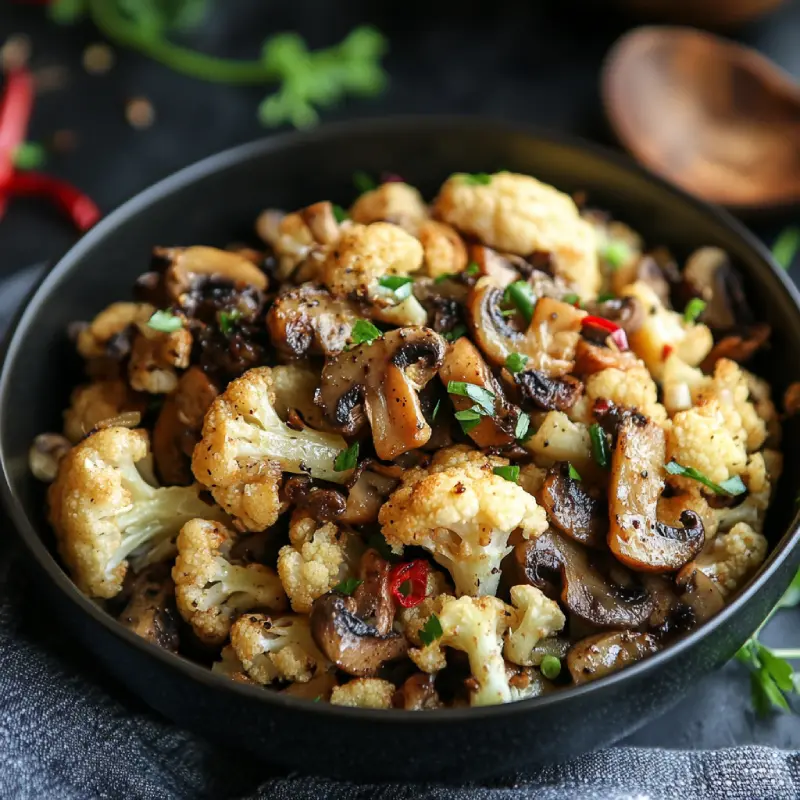Introduction
Cauliflower and mushrooms are a powerful pairing in the world of vegetarian and low-carb cuisine. Both vegetables are nutrient-dense, providing a great way to boost the nutritional content of your meals while keeping calories in check. Cauliflower is well-known for its high content of vitamins C and K, fiber, and its versatility as a low-carb substitute for grains and potatoes. On the other hand, mushrooms are packed with antioxidants, vitamins like B2 and D, and are an excellent source of plant-based protein.
The combination of cauliflower and mushrooms is not only healthy but also very flavorful. These ingredients complement each other beautifully: cauliflower’s mild taste pairs well with the umami-rich flavor of mushrooms, making it an ideal choice for creating hearty dishes that are also low in calories. For example, roasting these vegetables brings out their natural sweetness and creates an excellent texture contrast.
This pairing is also highly adaptable to various cuisines, from Mediterranean-style dishes featuring olive oil, garlic, and herbs to Indian-inspired curries with spices like turmeric and cumin. You can experiment with flavors and easily incorporate them into your diet, regardless of your culinary preferences.
Health Benefits of Cauliflower and Mushrooms
Cauliflower and mushrooms are rich in vitamins and minerals, making them excellent additions to a healthy diet. Cauliflower is a great source of vitamins C and K, folate, and fiber, all of which support immune function, bone health, and digestion. Mushrooms, on the other hand, are high in B vitamins like riboflavin (B2) and niacin (B3), which are essential for energy metabolism and maintaining healthy skin. Both vegetables are also low in calories, making them ideal for weight management.
One of the key benefits of these ingredients is their contribution to immune support. Cauliflower contains antioxidants like glucosinolates, which help reduce inflammation and fight off harmful free radicals. Similarly, mushrooms are often considered a superfood because of their immune-boosting properties, thanks to the presence of beta-glucans, which help modulate the immune system and improve overall health.
These vegetables are suitable for various diets, including keto, vegan, and low-carb. Cauliflower is commonly used as a low-carb substitute for grains, while mushrooms provide a savory depth of flavor that works well in vegan dishes. For those on a ketogenic diet, cauliflower’s low carbohydrate content and mushrooms’ ability to add umami make them perfect ingredients to create filling, nutritious meals without excess carbs.
Cauliflower and Mushroom Recipe Variations
Recipe 1: Simple Garlic Butter Cauliflower and Mushrooms
Ingredients
- 1 head of cauliflower, cut into florets
- 12 ounces mushrooms (cremini or button), sliced
- 4 tablespoons unsalted butter
- 3 cloves garlic, minced
- 1 tablespoon olive oil
- Salt and pepper to taste
- 1 tablespoon fresh parsley, chopped
Step-by-step Instructions
- Heat the olive oil and butter in a large skillet over medium heat until the butter is melted.
- Add the garlic and sauté for 1-2 minutes until fragrant.
- Add the cauliflower florets and mushrooms to the skillet, stirring well to coat them in the garlic butter mixture.
- Cook for about 10-12 minutes, stirring occasionally, until the cauliflower is tender and the mushrooms are golden brown.
- Season with salt and pepper, then sprinkle with fresh parsley before serving.
Tips for Perfect Results
- Use fresh herbs like parsley or thyme to enhance the flavor.
- Avoid overcooking the cauliflower to retain its slightly firm texture.
- For extra depth of flavor, add a splash of lemon juice before serving.
Recipe 2: Roasted Cauliflower and Mushrooms with Herbs
Ingredients and Seasoning Tips
- 1 head cauliflower, cut into florets
- 10 ounces mushrooms, halved
- 2 tablespoons olive oil
- 1 teaspoon rosemary, chopped
- 1 teaspoon thyme, chopped
- Salt and pepper to taste
- Optional: ½ teaspoon cayenne pepper for a spicy kick or 1 tablespoon balsamic vinegar for tanginess
Cooking Process
- Preheat the oven to 400°F (200°C).
- In a large mixing bowl, combine the cauliflower florets and mushrooms.
- Drizzle with olive oil, then add rosemary, thyme, salt, pepper, and any optional seasonings like cayenne pepper or balsamic vinegar.
- Toss everything well to ensure the vegetables are evenly coated.
- Spread the mixture out on a baking sheet in a single layer.
- Roast in the preheated oven for 25-30 minutes, stirring halfway through, until the cauliflower is tender and the mushrooms are caramelized.
Serving Suggestions
- Serve this dish as a side to grilled chicken or fish.
- Pair it with a grain bowl for a complete vegetarian meal.
- Add a dollop of Greek yogurt mixed with herbs for a creamy, tangy finish.
FAQs Section
Can I use frozen cauliflower and mushrooms for this recipe?
Yes, you can use frozen cauliflower and mushrooms for these recipes. Be sure to thaw them completely and drain any excess moisture before cooking. Frozen vegetables tend to release more water, so ensuring they are properly drained will help maintain the right texture.
How do I store leftovers, and how long do they keep?
Leftovers can be stored in an airtight container in the refrigerator for up to 3 days. To reheat, use a skillet over medium heat or microwave in short bursts, stirring in between, to ensure even warming without overcooking.
Can I add other vegetables to these recipes?
Absolutely! You can add other vegetables like broccoli, bell peppers, or zucchini to these dishes. These additions provide more variety and can be roasted alongside the cauliflower and mushrooms, adjusting the cooking time as needed for each vegetable’s texture.
Conclusion
The versatility of cauliflower and mushrooms makes them an excellent choice for a wide range of dishes. Whether you’re preparing a simple garlic butter skillet, a roasted herb-infused dish, or experimenting with other spices and vegetables, these recipes cater to different tastes and dietary preferences. You can enjoy them as a side dish, a main meal component, or even as a creative addition to a grain bowl or salad.
Feel free to experiment with different herbs, spices, and even protein additions like chickpeas or tofu to make these dishes uniquely yours. The adaptability of these vegetables allows you to create a dish that suits your palate and nutritional needs. Try incorporating flavors like curry powder, smoked paprika, or even a hint of cinnamon for a unique twist.
We’d love to hear how you made these recipes your own! Share your versions, leave feedback, or tag us on social media. Your creativity can inspire others to enjoy these healthy and delicious recipes in new ways.

